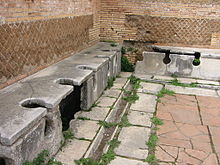

The xylospongium or tersorium, also known as a "sponge on a stick", was a utensil found in ancient Roman latrines, consisting of a wooden stick (Greek: ξύλον, xylon) with a sea sponge (Greek: σπόγγος, spongos) fixed at one end.
Academics disagree as to its exact use, about which the primary sources are vague. It has traditionally been assumed to be a type of shared anal hygiene utensil used to wipe after defecating, and the sponge cleaned in vinegar or water (sometimes salt water). Other recent research suggests it was most likely a toilet brush.
In the Baths of the Seven Sages in Ostia, a fresco from the 2nd century contains the Inscription (u)taris xylosphongio which is the first known mention of the term. Also in the early second century a papyrus letter of Claudius Terentianus to his father Claudius Tiberianus uses the term xylespongium in a phrase.
In the middle of the first century, the Roman philosopher Seneca the Younger reported that a Germanic gladiator died by suicide with a sponge on a stick. According to Seneca, the gladiator hid himself in the latrine of an amphitheatre and pushed the wooden stick deep into his throat.
See also
Citations
- Mirsky, Steve. "Getting to the Bottom". Scientific American. 308 (3): 85–85. doi:10.1038/scientificamerican0313-85.
- Nash, Stephen E. "What Did Ancient Romans Do Without Toilet Paper?". Sapiens. Retrieved 4 June 2019.
- Charlier, Philippe; Brun, Luc; Prêtre, Clarisse; Huynh-Charlier, Isabelle (2012-12-17). "Toilet hygiene in the classical era". BMJ. 345: e8287. doi:10.1136/bmj.e8287. ISSN 1756-1833. PMID 23247990.
- Garg, Pankaj; Singh, Pratiksha (July 2016). "Postdefecation Cleansing Methods: Tissue Paper or Water? An Analytical Review". Diseases of the Colon & Rectum. 59 (7): 696. doi:10.1097/DCR.0000000000000583. ISSN 0012-3706 – via Lippincott Williams & Wilkins.
- Wiplinger 2012, S. 300-301.
- L'Année épigraphique 1941, 5.
- Non magis quravit me pro xylesphongium ..., "He paid no more attention to me than to a sponge stick" (Michigan Papyri VIII 471 = CEL 146 = ChLA XLII 1220 29), "HGV". aquila.zaw.uni-heidelberg.de. Retrieved 2020-04-05.
- Seneca, Epistulae morales N. 70, vs. 20-21. ... lignum id, quod ad emundanda obscena adhaerente spongia positum est, totum in gulam farsit ..., "the stick, on which a sponge is placed for the cleaning of stuck filth, he stuffed all the way into his throat".
General references
Primary sources
- Claudius Terentianus, Michigan Papyri VIII 471 (inv. 5393) = CEL 146 = ChLA XLII 1220 29.
- Seneca, Epistulae morales Liber 8, 70, 20.
- Martial, Epigrammata, Liber 12,48,7.
Secondary sources
- Richard Neudecker: Die Pracht der Latrine. Zum Wandel öffentlicher Bedürfnisanstalten in der kaiserzeitlichen Stadt. Pfeil-Verlag, München 1994 (Studien zur antiken Stadt, Bd. 1) ISBN 3-923871-86-4, pp. 36f.
- Gilbert Wiplinger: "Der Gebrauch des Xylospongiums – eine neue Theorie zu den hygienischen Verhältnissen in römischen Latrinen". In: SPA . SANITAS PER AQUAM. Tagungsband des Internationalen Frontinus-Symposiums zur Technik – und Kulturgeschichte der antiken Thermen Aachen, 18. – 22. März 2009. Frontinus-Gesellschaft e.V. & Peeters, Leiden 2012. ISBN 978-90-429-2661-5. pp. 295–304.